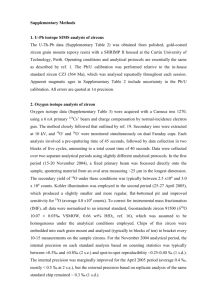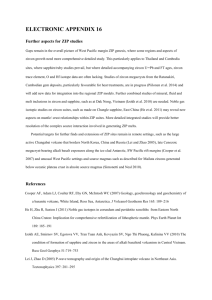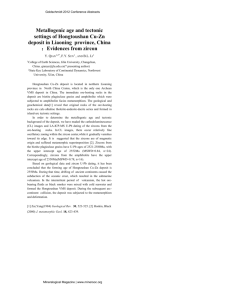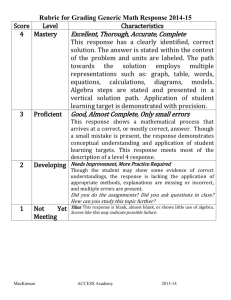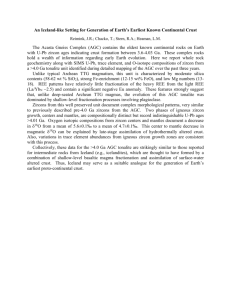Appendix X: analytical methods - Springer Static Content Server
advertisement
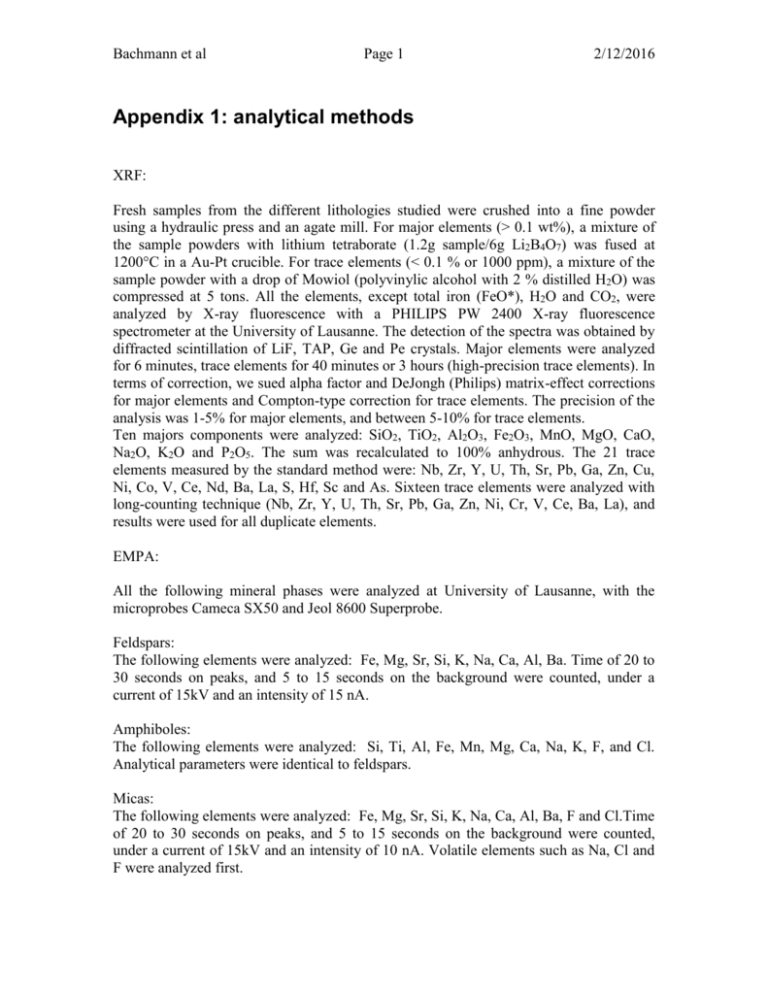
Bachmann et al Page 1 2/12/2016 Appendix 1: analytical methods XRF: Fresh samples from the different lithologies studied were crushed into a fine powder using a hydraulic press and an agate mill. For major elements (> 0.1 wt%), a mixture of the sample powders with lithium tetraborate (1.2g sample/6g Li2B4O7) was fused at 1200°C in a Au-Pt crucible. For trace elements (< 0.1 % or 1000 ppm), a mixture of the sample powder with a drop of Mowiol (polyvinylic alcohol with 2 % distilled H2O) was compressed at 5 tons. All the elements, except total iron (FeO*), H2O and CO2, were analyzed by X-ray fluorescence with a PHILIPS PW 2400 X-ray fluorescence spectrometer at the University of Lausanne. The detection of the spectra was obtained by diffracted scintillation of LiF, TAP, Ge and Pe crystals. Major elements were analyzed for 6 minutes, trace elements for 40 minutes or 3 hours (high-precision trace elements). In terms of correction, we sued alpha factor and DeJongh (Philips) matrix-effect corrections for major elements and Compton-type correction for trace elements. The precision of the analysis was 1-5% for major elements, and between 5-10% for trace elements. Ten majors components were analyzed: SiO2, TiO2, Al2O3, Fe2O3, MnO, MgO, CaO, Na2O, K2O and P2O5. The sum was recalculated to 100% anhydrous. The 21 trace elements measured by the standard method were: Nb, Zr, Y, U, Th, Sr, Pb, Ga, Zn, Cu, Ni, Co, V, Ce, Nd, Ba, La, S, Hf, Sc and As. Sixteen trace elements were analyzed with long-counting technique (Nb, Zr, Y, U, Th, Sr, Pb, Ga, Zn, Ni, Cr, V, Ce, Ba, La), and results were used for all duplicate elements. EMPA: All the following mineral phases were analyzed at University of Lausanne, with the microprobes Cameca SX50 and Jeol 8600 Superprobe. Feldspars: The following elements were analyzed: Fe, Mg, Sr, Si, K, Na, Ca, Al, Ba. Time of 20 to 30 seconds on peaks, and 5 to 15 seconds on the background were counted, under a current of 15kV and an intensity of 15 nA. Amphiboles: The following elements were analyzed: Si, Ti, Al, Fe, Mn, Mg, Ca, Na, K, F, and Cl. Analytical parameters were identical to feldspars. Micas: The following elements were analyzed: Fe, Mg, Sr, Si, K, Na, Ca, Al, Ba, F and Cl.Time of 20 to 30 seconds on peaks, and 5 to 15 seconds on the background were counted, under a current of 15kV and an intensity of 10 nA. Volatile elements such as Na, Cl and F were analyzed first. Bachmann et al Page 2 2/12/2016 Fe-Ti oxides: The following elements were analyzed: Fe, Mg, Mn, Si, Ti, Al, Cr and V. Time of 20 seconds on peaks, and 10 seconds on the background were counted, under a current of 15 to 20kV and an intensity of 15 nA. Melt inclusions and glasses: The following elements were analyzed: Fe, Mg, Mn, Si, K, Na, Ca, Al, Ti, Ba, P, S, Cl and F. Time of 20 to 30 seconds on peaks, and 5 to 15 seconds on the background were counted, under a current of 15kV and an intensity of 10 nA. Volatile elements such as Na, F, Cl and S were analyzed first. Zircons: Zircons were analyzed at University of Washington using a Jeol 733. The following elements were analyzed: Hf, Fe, P, Ce, Yb, Y (stochiometric concentration were used for Zr and Si). Counting times on peaks were 180 sec for Hf and Yb (LIF-spectrometer) and Ce and Ti (PET-spectrometer), and 360 sec for P and Y (TAP-spectrometer), respectively 95 to 15 seconds on the background), under a current of 15 kV and an intensity of 200 nA. SHRIMP: Several samples from the KPT, Nisyros Upper and Lower Pumice units, Nikia lava flow and Yali rhyolite were selected for trace element analysis. Zircons were separated using standard procedures at University of Washington, mounted in epoxy, polished, and imaged by cathodoluminescence on an Hitachi 3400 scanning electron microscope at University of Puget Sound. Spots on the zircons 30–40 μm in diameter were analyzed using the USGS/Stanford Sensitive High Resolution Ion Microprobe, Reverse Geometry (SHRIMP-RG). Zircon standard MAD was used as the trace element concentration standard. LA MC ICP-MS Sample Preparation and Analysis The preparation of the samples for in-situ, multi-grain, and whole rock analysis of Hf isotopes and composition was conducted in the facilities of the Earth and Space Sciences department at the University of Washington. For Hf analysis, zircons were separated from the rhyolitic material via crushing, sieving, flotation of the <250m fraction with a gold pan, magnetic separation with hand magnets and a Frantz magnetic separator, heavy liquid separation in low viscosity sodium polytungstate (Na6(H2W12O40), Geoliquids inc.), and 3-4 days of bathing in 48% HF (ACS grade) to dissolve unwanted phases, especially monazite (similar optical behavior), from the zircon aliquot. Dissolution of zircons for solution analysis of Hf isotope composition was conducted in large Parr bombs (Parr Instrument Co., Moline, IL; Parrish 1987) loaded with eight 1ml microcapsules, which each hold 3-5 zircons of one sample. The whole procedure was conducted as designed for zircon Pb-isotope analysis, including the cleaning of the microcapsules and bombs with alternating steps of 6M HCl and 24M HF (Seastar high-purity subboiling grade). The zircons were digested in 0.2 ml of 24M HF in Bachmann et al Page 3 2/12/2016 each microcapsule, and 6 ml of 24M HF in the Teflon liner, at 220C for 65h. The zircon digests were flushed out of the microcapsules, which then were rinsed three times with 24M HF. After drying the sample it was taken up in a mixture of 1M HCl and 4M HF, and the hafnium was separated from the digests on the second column following the procedure of (Blichert-Toft et al. 1997) by using a modified succession of HCl and HF with varying acidities. Hf separates were dissolved in 2% HNO3 and analyzed with sample introduction by desolvating nebulizer, following the same conditions and procedures as used during the in-situ analyses (see below). Laser and Multicollector ICP-MS Configuration and Analysis A LA-MC-ICPMS system comprising a UP193 solid state NewWave laser attached to a Nu Plasma HR multicollector-ICPMS was used for zircon Hf isotope analyses (on grain mounts). The New Wave UP193 solid state Nd-YAG laser source is attached to the Nu Plasma HR multicollector via the desolvating nebulizer (DSN). During the entire measurement, DI water was passed through the DSN. Ablated samples are introduced from the laser into the line after the DSN with an Ar gas carrier. Between analyses and prior to each sample change the tubing coming from the DSN was washed out using 2% HNO3 for 2-5 min. The tubing from the laser to the main line is kept short (< 30 cm) since it is not washed out. This portion is replaced prior to each laser session. After each sample change the sample chamber is purged for 3min to avoid blowing out the torch by remaining air. Analyses are continued after the signal of the liquid standard JMC 475 has stabilized and additional acid and RODI H2O washouts have finished. Hf laser analyses were conducted in a bracketing sequence to monitor the instrumental drift and to enable external standard corrections. Each bracket comprised a sequence of solution standard > solid standard (Plesovice zircon; Slama et al. 2008) > 1-5 samples > solid standard > solution standard (JMC 475). Plesovice zircons were checked for Hf heterogeneities prior to usage via multiple random continuous line scans. Typical measurement conditions for samples and standards are listed in Table 1. The cup configuration for Hf isotope analysis is presented in Table 2. Corrections and Error Propagation Correction of the 176Hf/177Hf ratio for isobaric interferences by 176Yb and 176 Lu and of the 180Hf/177Hf ratio for 180W and 180Ta follow the same protocol during laser and solution analyses. Corrections for instrumental mass fractionation were calculated using the exponential law of Russell et al. 1978. Each solid standard (Table 3) was corrected externally for machine drift through the liquid standard results before standard corrections were applied to each sample. For machine drift corrections of the Plesovice standard, the JMC 475 standard value of 176 Hf/177Hf = 0.282157 was used for normalization. Hf values were calculated with the chondritic value given by Blichert-Toft and Albarède (1997) of 176Hf/177Hf = 0.282772. No age corrections were applied since Hf ingrowth is insignificant over the ages of the samples of <1 Ma (Bachmann et al. 2010). The actual measurement errors were propagated by using this equation: Bachmann et al Page 4 2 samplemeas s.d.STDmeas1 x samplecorr samplecorr samplemeas AvgSTDmeas1 x 2/12/2016 2 with samplecorr meaning the sample result has undergone interference, drift, and standard corrections, STD standing for the Plesovice zircon standard or JMC 475 Hf solution standard, respectively. Laser result errors were propagated by using the average and standard deviation of all Plesovice zircon standard analyses of each day (each analysis being drift corrected for the JMC 475 and then corrected for the true Plesovice value) in brackets between the two standards around it. Whole rock and zircon digest errors were propagated similarly by using the average and standard deviation of all JMC 475 analyses (each interference corrected value bracketed between the two interference and true value corrected ones around it). According to Kamenov et al. (2008) the precision and accuracy of Hf isotope data obtained through interference corrections for Lu and Yb is better than ±1 epsilon unit for corrections of 20% between the raw 176Hf/177Hf ratio and the internally corrected ratio (in ideal synthetic zircons). For corrections up to 60%, the uncertainty increases to +/- 4 Hf, and to +/- 9 Hf for corrections of up to 80%. We therefore only use those results that have <40% corrections to limit the uncertainty. MSWDs (mean standard weighted deviations) presented in Table 2 of the main text are calculated accordingly only from values that fulfill this criterion. In addition the calculation of the errors for Hf is based on the degree of correction. The accuracy of results for samples is limited by the discrepancy in Yb corrections between Plesovice (8%) and most samples (<40%). A standard with higher Yb and Lu corrections than Plesovice could be incorporated in the standard correction process to increase the accuracy (Vervoort et al. 2007). The accuracy and precision of the laser ablation system is validated by the repeated measurement of the Plesovice standard throughout all measurement sessions. All Plesovice standard analyses yield an average of 0.282471±0.000008 (n=104) that is within the 2 error of the true value of Slama et al. (2008) of 0.282482±0.000013, suggesting homogenous 176Hf/177Hf and 176Yb/177Hf compositions (Figure 1). This homogeneity is required to ensure reliable Yb corrections. While standard analyses cluster tightly in 176Hf/177Hf vs. 176Yb/177Hf space around the true 176Hf/177Hf ratio of 0.282482, with 176Yb/177Hf ratios of 0.0244, zircons from the Aegean volcanic rocks scatter between 0.282209 and 0.283088 (Figure 1 and Table Appendix 2), with a 176 Yb/177Hf ratio of up to 0.32. According to Griffin et al. (2000), a lack of correlation as shown in figure 1 is an indicator that the corrections imposed to the 176Hf/177Hf ratio result in accurate and precise data. References: Bachmann O, Schoene B, Schnyder C, Spikings R (2010) 40Ar/39Ar and U/Pb dating of young rhyolites in the Kos-Nisyros volcanic complex, Eastern Aegean Arc (Greece): age discordance due to excess 40Ar in biotite. Geochem. Geophys. Geosyst 11, Q0AA08, doi:10.1029/2010GC003073. Blichert-Toft J, Albarède F (1997) The Lu-Hf isotope geochemistry of chondrites and the evolution of the mantle-crust system. Earth and Planetary Science Letters 148(12):243-258 Bachmann et al Page 5 2/12/2016 Blichert-Toft J, Chauvel C, Albarède F (1997) Separation of Hf and Lu for high-precision isotope analysis of rock samples by magnetic sector-multiple collector ICP-MS. Contributions to Mineralogy and Petrology 127:248-260 Griffin WL, Pearson NJ, Belousova E, Jackson SE, van Achterbergh E, O'Reilly SY, Shee SR (2000) The Hf isotope composition of cratonic mantle: LAM-MCICPMS analysis of zircon megacrysts in kimberlites. Geochimica et Cosmochimica Acta 64(1):133-147 Kamenov GD, Mueller PA, Mazdab FK (2008) Using synthetic zircons to test the reliability of the Lu-Yb isobaric interference correction of Hf isotopic measurements during laser ablation MC-ICP-MS analyses. In: AGU Fall Conference, vol 89 (53) Abstract V13A-2093. Eos Trans., San Francisco Russell WA, Papanastassiou DA, Tombrello TA (1978) Ca isotope fractionation on the Earth and other solar system materials. Geochimica et Cosmochimica Acta 42(8):1075-1090 Slama J, Kosler J, Condon DJ, Crowley JL, Gerdes A, Hanchar JM, Horstwood MSA, Morris GA, Nasdala L, Norberg N, Schaltegger U, Schoene B, Tubrett MN, Whitehouse MJ (2008) Plesovice zircon -- A new natural reference material for U-Pb and Hf isotopic microanalysis. Chemical Geology 249(1-2):1-35 Vervoort JD, DuFrane SA, Hart GL (2007) An assessment of the total uncertainty in Hf analyses by LA-MC-ICPMS. In: AGU Fall meeting, vol 88(52) Abstract V51B0569. San Francisco Bachmann et al Page 6 2/12/2016 0.35 Plesovice 0.3 176Yb/177Hf KPT 0.25 KS 0.2 Nis Nikia 0.15 Yali 0.1 0.05 0 0.2820 0.2824 0.2828 0.2832 176Hf/177Hf Figure 1: Comparison of 176Yb/177Hf vs. 176Hf/177Hf of standard analyses (Plesovice; Slama et al. 2008) and sample analyses. Correction of 176Hf for 176Yb and 176Lu was conducted by using the -Hf fractionation factor. Absence of correlation between 176Yb/177Hf and 176Hf/177Hf suggest a reliable Yb correction (Griffin et al., 2000). Bachmann et al Page 7 2/12/2016 Table 1: Instrumentation parameters during laser analysis Coolant Ar gas flow rate Auxiliary Ar gas flow rate Carrier He gas flow rate Forward RF power Reflected RF power Interface cones Analyzer vacuum Acceleration voltage Focusing optics Repetition rate Spot size Energy density Typical total Hf sensitivity Optimized for laser Optimized for solutions 13 l/min 0.80 l/min 0.80 l/min 1300 W <11 W Nickel 8 x 10-9 mbar 10 Hz 35-100 nm 1-6 J/cm2 8 V for 100 ppb 18 V for 100 ppb Table 2: Cup configuration during laser ablation H6 Hf H5 H4 181 H3 180 H2 179 H1 178 Ax 177 L1 176 L2 175 IC0 L3 173 IC1 L4 171 IC2 L5 Bachmann et al Page 8 2/12/2016 Table 3: 176Hf/177Hf ratios of Plesovice standard zircons (Slama et al. 2007) determined over the whole range of Hf analysis presented in this paper; the average (n=104) is given in the second to last row, the result for one multi-grain digest is given in the last row Sample Plesovice Hf std #1 090121_Plesovice_M1C4_#2 Plesovice Hf std #3 Plesovice Hf std #4 Plesovice Hf std #5 Plesovice Hf std #6 Plesovice Hf std #7 Plesovice Hf std #8 Plesovice Hf std #9 Plesovice Hf std #10 Plesovice Hf std #11 Plesovice Hf std #12 Plesovice Hf std #13 Plesovice Hf std #14 Plesovice Hf std #15 Plesovice Hf std #17 090123 Plesovice M1C #1 090123 Plesovice M1C #2 090123 Plesovice M1C #3 090123 Plesovice M1C #4 090123 Plesovice M1C #5 090123 Plesovice M1C #6 090123 Plesovice M1C #7 090123 Plesovice M1C #8 090123 Plesovice M1C #9 090123 Plesovice M1C #10 090123 Plesovice M1C #11 090124 Plesovice M1C4 #1 090124 Plesovice M1C4 #2 090124 Plesovice M1C4 #3 090124 Plesovice M1C1 #5 090124 Plesovice M1C3 #6 090124 Plesovice M1C3 #7 090124 Plesovice M1C3 #9 090124 Plesovice M1C3 #10 090124 Plesovice M1C3 #11 090124 Plesovice M1C3 #12 090124 Plesovice M1C3 #13 090125 Plesovice M1C3 #1 090125 Plesovice M1C3 #2 090125 Plesovice M1C3 #3 090125 Plesovice M1C3 #4 090125 Plesovice M1C3 #5 090125 Plesovice M1C3 #6 090125 Plesovice M1C3 #7 090125 Plesovice M1C3 #9 090125 Plesovice M1C3 #10 090519_Plesovice_M1C1_#1 090519_Plesovice_M1C1_#2 090519_Plesovice_M1C1_#3 090519_Plesovice_M1C1_#4 090519_Plesovice_M1C1_#5 Average 090714_Plesovice_#VIII digest 176 Hf/177Hf corrected 0.282420 0.282468 0.282519 0.282480 0.282494 0.282472 0.282522 0.282511 0.282511 0.282489 0.282452 0.282478 0.282507 0.282515 0.282557 0.282469 0.282443 0.282400 0.282455 0.282539 0.282422 0.282436 0.282513 0.282445 0.282526 0.282518 0.282421 0.282408 0.282512 0.282475 0.282595 0.282386 0.282415 0.282469 0.282507 0.282457 0.282414 0.282465 0.282501 0.282433 0.282433 0.282383 0.282394 0.282443 0.282425 0.282471 0.282503 0.282440 0.282514 0.282473 0.282482 0.282493 0.282471 0.282480 Sample 090519_Plesovice_M1C1_#6 090519_Plesovice_M1C1_#8 090519_Plesovice_M1C1_#9 090519_Plesovice_M1C1_#10 090520_Plesovice_M1C1_#1 090520_Plesovice_M1C1_#2 090520_Plesovice_M1C1_#3 090520_Plesovice_M1C1_#4 090520_Plesovice_M1C1_#5 090520_Plesovice_M1C1_#6 090520_Plesovice_M1C1_#7 090520_Plesovice_M1C1_#8 090520_Plesovice_M1C1_#9 090520_Plesovice_M1C1_#10 090520_Plesovice_M1C1_#11 090520_Plesovice_M1C1_#12 090520_Plesovice_M1C3_#13 090520_Plesovice_M1C3_#14 090521_Plesovice_M1C5_#1 090521_Plesovice_M1C5_#2 090521_Plesovice_M1C5_#3 090521_Plesovice_M1C5_#4 090521_Plesovice_M1C5_#5 090521_Plesovice_M1C5_#6 090521_Plesovice_M1C5_#7 090521_Plesovice_M1C5_#8 090521_Plesovice_M1C5_#9 090521_Plesovice_M1C5_#10 090521_Plesovice_M1C5_#11 090521_Plesovice_M1C5_#12 090521_Plesovice_M1C5_#13 090521_Plesovice_M1C5_#14 090521_Plesovice_M1C5_#15 090522_Plesovice_M1C5_#1 090522_Plesovice_M1C5_#2 090522_Plesovice_M1C5_#3 090522_Plesovice_M1C5_#4 090522_Plesovice_M1C5_#5 090522_Plesovice_M1C5_#6 090522_Plesovice_M1C5_#7 090522_Plesovice_M1C3_#8 090522_Plesovice_M1C3_#9 090523_Plesovice_M1C3_#1 090523_Plesovice_M1C3_#2 090523_Plesovice_M1C3_#3 090523_Plesovice_M1C3_#4 090523_Plesovice_M1C3_#5 090523_Plesovice_M1C3_#6 090523_Plesovice_M1C3_#7 090523_Plesovice_M1C3_#8 090523_Plesovice_M1C3_#9 090523_Plesovice_M1C3_#10 2 s.d. 1 s.d. 176 Hf/177Hf corrected 0.282533 0.282467 0.282491 0.282462 0.282454 0.282442 0.282448 0.282481 0.282481 0.282471 0.282493 0.282438 0.282494 0.282517 0.282493 0.282441 0.282464 0.282474 0.282402 0.282478 0.282487 0.282482 0.282503 0.282486 0.282535 0.282487 0.282420 0.282474 0.282429 0.282429 0.282502 0.282472 0.282503 0.282472 0.282424 0.282481 0.282438 0.282469 0.282487 0.282526 0.282556 0.282469 0.282462 0.282470 0.282451 0.282401 0.282521 0.282433 0.282507 0.282499 0.282416 0.282354 0.000008 0.000022
